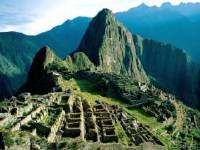Profile
Blog
Photos
Videos
René and I travelled the two hours to Pisco on a full, public bus, to find Pisco ´same same but different´ as any other small Peruvian town. It´s built around the central Plaza De Armas, with all the main tour agencies at the sides of the plaza, within easy reach for the tourists.
A side note about the agencies; in the small towns where they vye for your business, it doesn´t matter who you go with. You end up getting on exactly the same bus you´d have got on had you gone with the other tour agency. It was amusing to René and I when the other agencies tried to tell us the other tour people weren´t as good as them. Through the day, your guide changes, the groups change depending on what deal you´ve bought. Your best bet is to have a laugh with the agencies, barter, and play them off against each other. They all know how much each other will set the price at, and how much they are prepared to lower the price. We laughed off attempts by some tour agencies to tell us the agency we´d gone with were shysters, and that even though they were in the Lonely Planet guide and they were at the correct address listed, they didn´t actually exist as a company. You know, some people will try anything to scare you into buying their custom! In the end, we bartered down to a cheaper deal. There wasn´t much budge on this one.
After a comfortable sleep in a friendly, well-kept hospedaje, we were picked up arund 7am. When the bus stopped outside some of the other agencies we´d been to, we saw the owners we´d been bartering with - their customers were getting on our bus! Anyway, we arrived at the port, where a boat would take about an hour to get us to Isla Ballestas, often referred to as ´the poor man´s Galapagos´. On the way, we stopped for some picture taking of the Candelabra, which is a huge three pronged fork-looking object etched into the sand. No one knows who made this, or why. Theories say it was piractes, some say sailors for directional purposes, as it´s aligned north-south, then our old friend, Erich von Daniken (of Nazca alien theory fame) thinks unsurprisingly, it was made by our galactic neighbours. At the island, we saw lots of sea lions, Humboldt penguins and lots of guano-producing birds such as cormorants, Peruvian boobies (I don´t think I was the only one who sniggered when the guide said that - childish, I know) and pelicans. Apparently, the guano is ´harvested´ every four years, and is as valuable as it´s weight in gold, literally.
After, we visited the Paracas National Reserve, where we saw some Chilean flamingoes from a distance, a small museum and the salt flat bed where thousands of years ago, the Paracas culture lived. Along the way back, we saw a rock formation known as ´the Cathedral´, formed from the waves crashing and eroding the rock over millions of years.
I chatted to our guide and told him the story of how my guide at the Inca Trail said we should take a stone from the start of our trail, and leave it along the way, as an offering. I left my stone at the highest most point of the Inca Trail, at Dead Woman´s Pass, an altitude of 4,200 metres. It was there I picked up another stone, but had forgotten to leave it at the top of Wayña Picchu, the end of my Inca Trail. I had carried that stone in my bag, waiting for a time to offer it back, and now seemed a good a time as any. So, illustrating my story by showing my guide the stone I clasped in my hand, he gave me his blessing to hurl the stone into the sea. There was something about taking it from the highest point of the Inca Trail and releasing it to the sea that seemed right. In a ceremonial end in front of the natural Cathedral before me, I hurled the stone and it took flight, spinning, curling and falling towards its new home for the next million years!
Happy that I´d given peace between the mountains and seas, and who knows, appeased some natural disaster with my meagre offering, we returned to Pisco to catch a late bus onwards to Lima.
- comments




